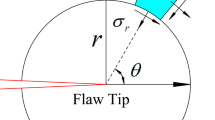Abstract
In this paper the biaxial Iosipescu test method has been used, employing specimens with a central precrack placed along the notch-root axis, to study the intralaminar failure properties of a unidirectional carbon/epoxy composite under mixed-mode (dominated by shear) loadings. A linear finite element analysis has been performed to determine the energy release rates and stress intensity factors for the central crack under various biaxial loading conditions. In addition, a series of simple and biaxial fracture experiments have been performed on the composite material. Numerical results indicate that the method is capable of generating a wide range of mixed-mode loading conditions at the crack tip for various loading angles and crack lengths. Using the numerical results, in conjunction with experimental data, the biaxial intralaminar failure process in the cracked Iosipescu specimens has been explained.
Similar content being viewed by others
References
E.M. Wu, Journal of Applied Mechanics 34, no. 4 (1967) 967–974.
J.M. McKinney, Journal of Composite Materials 6 (1972) 164–166.
R.A. Jurf and R.B. Pipes, Journal of Composite Materials 16 (1982) 386–394.
A.J. Russell and K.N. Street, in ASTM 976 (1985) 349–370.
W.R. Broughton, M. Kumosa and D. Hull, Composites Science and Technology 38 (1990) 299–325.
W.R. Broughton, ‘Shear properties of unidirectional carbon fiber composites’, Ph.D. thesis, University of Cambridge, U.K. (1989).
N. Iosipescu, Journal of Materials 2, no. 1 (1967) 537–566.
D.E. Walrath and D.F. Adams, Experimental Mechanics 23, no. 1 (1983) 105–110.
D.F. Adams and D.E. Walrath, Experimental Mechanics 27, no. 2 (1987) 113–119.
J.A. Barnes, M. Kumosa and D. Hull, Composites Science and Technology 28 (1987) 251–268.
M. Kumosa and D. Hull International Journal of Fracture 35 (1987) 83–102.
J. Morton, H. Ho, M.Y. Tsai and G.L. Farley, Journal of Composite Materials 26, no. 5 (1992) 708–750.
A. Voloshin and M. Arcan, Experimental Mechanics 20, no. 8 (1980) 280–284.
A. Bansal and M. Kumosa, Journal of Composite Materials 29, no. 3 (1995) 334–358.
M.V. Balakrishnan and M. Kumosa, ‘Biaxial testing of a SiC-Ti metal matrix composite’, Annual report to GE Aircraft Engines, 1993.
G.J. DeSalvo and R.W. Gorman, in Ansys Engineering Analysis System: User's Manual, vol. 1, Swanson Analysis Systems Inc. (1989).
G.C. Sih, P.C. Paris and G.R. Irwin, International Journal of Fracture 1 (1965) 189–203.
S. Parhizgar, L.W. Zachary and C.T. Sun, International Journal of Fracture 20 (1982) 247–256.
E.F. Rybicki and M.F. Kanninen, Engineering Fracture Mechanics 9 (1977) 931–938.
F.G. Buchholz and M.F. Kanninen, ‘Fracture analysis by the improved and generalized modified crack closure integral’, Paper presented at 1 st World Congress on Computation Mechanics, Austin, Texas (1986).
I.S. Raju, Engineering Fracture Mechanics 28 (1987) 251–274.
R. Sethuraman and S.K. Maiti, Engineering Fracture Mechanics 30, no. 2 (1988) 227–231.
T.K. O'Brien, in Damage in Composite Materials, ASTM STP 775, K.L. Reifsnider (ed.) (1982) 140–167.
N. Sukumar and M. Kumosa, International Journal of Fracture 62, no. 1 (1993) 55–85.
A.C. Kaya and F. Erdogan, International Journal of Fracture 16, no. 2 (1980) 171–190.
Acoustic emission monitoring system AET 5500 (Operating Instructions), Hartford Steam Boiler Inspection Technologies, Sacramento, Ca., U.S.A., Software Version D07 (Nov. 1990).
C. Corleto, W. Bradley and M. Henriksen, in 6th International Conference on Composite Materials, F.L. Matthews, N.C.R. Buskell, J.M. Hodgkinson, J. Morton (eds.), Elsevier Science Publishers Ltd., UK, vol. 3 (1987) 378–387.
H.T. Hahn, Composites Technology Review 5, no. 1 (1983) 26–29.
G.S. Giare, A. Herold, V. Edwards and R.R. Newcomb, Engineering Fracture Mechanics 30, no. 4 (1988) 531–545.
J.G. Williams, Composites Science and Technology 35 (1989) 367–376.
X.N. Huang, ‘Mode I and mode II intralaminar fracture of unidirectional composites’, Ph.D. thesis, University of Cambridge, U.K. (1990).
N. Sukumar and M. Kumosa, International Journal of Fracture 58 (1992) 177–192.
V.D. Azzi and S.W. Tsai, Experimental Mechanics 5 (1965) 283–288.
Author information
Authors and Affiliations
Rights and permissions
About this article
Cite this article
Bansal, A., Kumosa, M. Application of the biaxial Iosipescu method to mixed-mode fracture of unidirectional composites. Int J Fract 71, 131–150 (1995). https://doi.org/10.1007/BF00033752
Received:
Accepted:
Issue Date:
DOI: https://doi.org/10.1007/BF00033752




